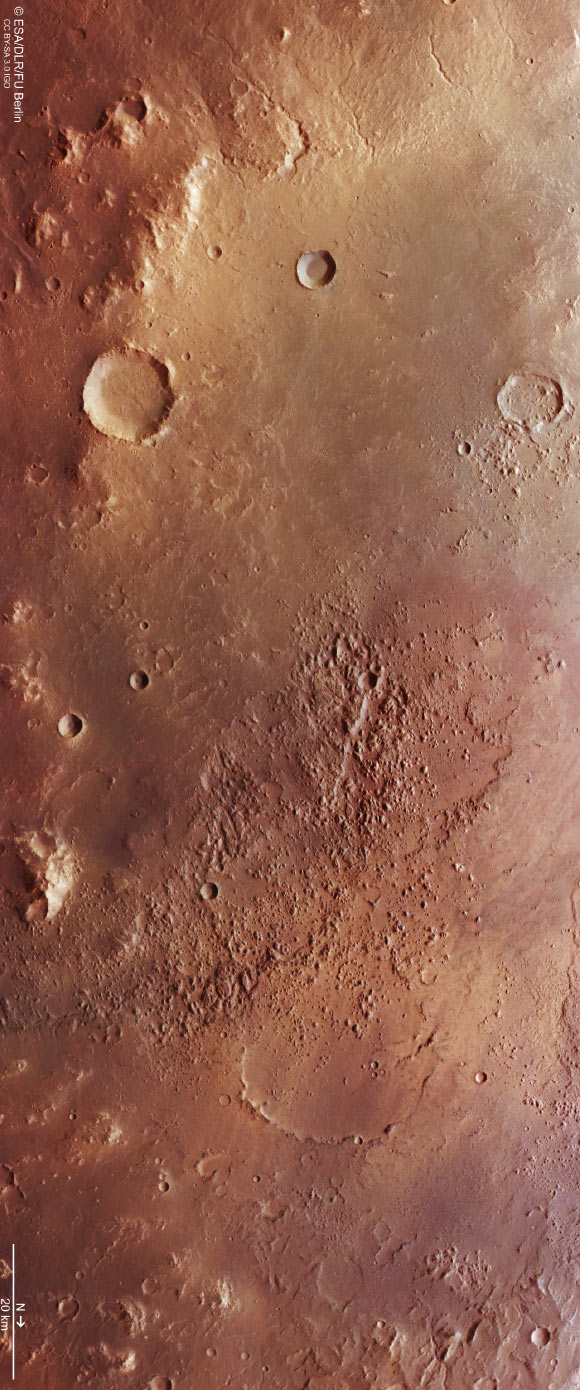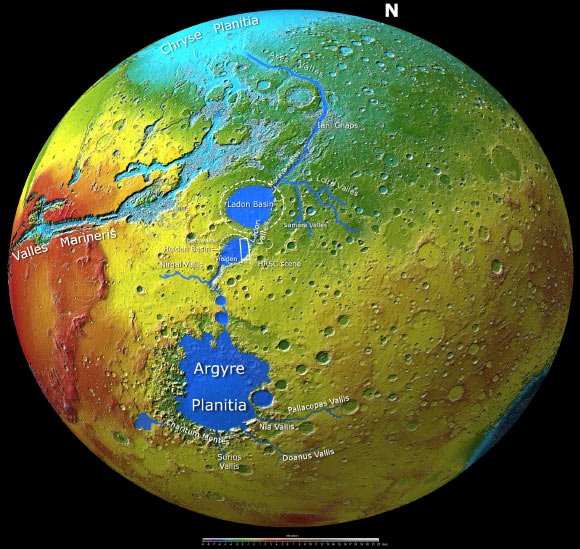The new images, taken with the High Resolution Stereo Camera (HRSC) aboard ESA’s Mars Express spacecraft on April 24, 2022, show the Holden Basin in the southern Martian highlands — part of a region that is a high-ranking target in the search for signs of ancient Martian life.

This image from ESA’s Mars Express shows a portion of the Uzboi-Ladon-Morava outflow system. Image credit: ESA / DLR / FU Berlin / CC BY-SA 3.0 IGO.
The Holden Basin and the 140-km-wide Holden crater located there, named after the American astronomer Edward Singleton Holden, are part of the so-called Uzboi-Ladon-Morava outflow system.
This 8,000-km-long outflow system consisting of a multitude of valleys and depressions through which water was transported from the southern Argyre Planitia to Chryse Planitia in the northern Martian lowlands.
The complex history of this system makes it an interesting target to explore in more detail with Mars orbiters and rovers.
“The entire region could be an interesting target in the search for ancient life on Mars,” said members of the Mars Express science team.
“Our experience on Earth tells us that where there is water, there is life: could the same have been true billions of years ago on Mars?”
Prior to the impact that created the Holden crater, the Uzboi-Ladon-Morava outflow system consisted of a long and continuous series of channels and depressions that emerged from the Argyre Basin and flowed north through the Uzboi Valley into the Holden Basin.
From there, it continued through the Ladon Valles into the, also unofficially named, Ladon Basin, which is also thought to represent a very large ancient impact basin.
Eventually, the drainage continued northwards through the Morava Valles.
It is assumed that even Ares Vallis was formed by outflows of the Uzboi-Ladon-Morava system.

This image was created using data from the Mars Orbiter Laser Altimeter (MOLA) instrument on NASA’s Mars Global Surveyor mission. It shows the complete Uzboi-Ladon-Morava outflow system. The area outlined by the bold white box indicates part of the Holden Basin, which was imaged by the Mars Express High Resolution Stereo Camera on April 24, 2022, during orbit 23133. The dashed circles depict the informally named Holden and Ladon Basins. Image credit: MOLA Science Team / FU Berlin / CC BY-SA 3.0 IGO.
The first mobile Mars robot, Sojourner, landed and operated in Ares Vallis estuary exactly 25 years ago.
The investigations in 1997 revealed that episodic and enormous water masses flowing downhill with great energy had shaped the landscape there.
Taken together, the total area drained may have covered up to 9% of the Martian surface.
The impact that created the Holden crater most likely occurred during the Late Noachian (3.85 to 3.7 billion years ago), after the main activity of the Uzboi-Ladon-Morava system.
The formation of the crater disrupted the drainage system, but the Uzboi valley to the south breached the crater walls, which were up to 900 m high, and made Holden the terminal basin for the Uzboi and Nirgal valleys.
A river delta formed at the confluence of Uzboi Vallis and the crater, providing irrefutable evidence that a lake formed in the Holden crater.
A similar, quite well-known river delta can be found directly north of Holden, in the Eberswalde crater.
This bird-foot delta was once proposed as a landing site for NASA’s Mars Science Laboratory mission, which included the Curiosity rover, but did not win the race against the other candidates.
Although there is no visible outflow valley at Holden, a collapse area can be seen on the east side of the crater.
There is no evidence of significant post-impact outflow or throughflow, but some minor outflow may have occurred along the Uzboi-Ladon-Morava system after the crater was formed.
Certainly, the floor of the basin where the crater was formed was then backfilled with large amounts of ejecta.
The complex history of the Uzboi-Ladon-Morava system coupled with the overprinting by impacts makes the region an interesting target for future exploration.
In addition, both Ladon Valles and the Holden crater in particular contain layered and clay mineral-rich sediments that could preserve traces of microbial life particularly well, making them potential targets in the search for ancient life on the Red Planet.
“Holden crater and Ladon Valles — both of which lie just outside the imaged area, and can be seen in the new images — may be particularly interesting as they contain layered and phyllosilicate-bearing deposits,” the researchers said.
“Phyllosilicates are a type of mineral also found on Earth, with one example being clay.”
“They could serve as a reaction center for organic molecules, which make up all living things on Earth; past experiments suggest that phyllosilicates could have played a role in the origin of life.”







